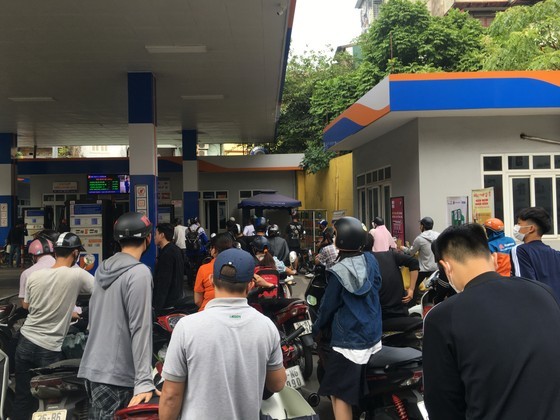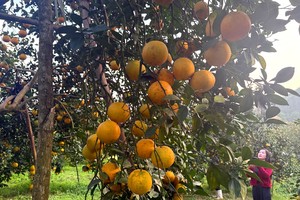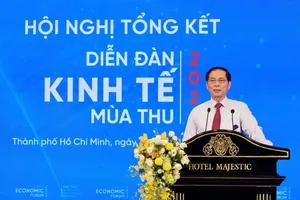
This morning - one day before the time will adjust the domestic petrol price, many gas filling stations in Hanoi still had congested with long lines of vehicles waiting for refueling.
In some northern provinces of Bac Giang, Bac Ninh, and Hoa Binh, staff of fuel filling stations just sold only VND30,000-50,000 worth of fuel to any customer.
According to a representative of the Vietnam National Oil and Gas Group (Petrolimex), in a few days of October, the petroleum output of stores under this system in Ho Chi Minh City has increased by 2.4 times compared to the previous months while the volume of petrol and oil for sale in the early days of November increased by an average of 35-40 percent compared to October in Hanoi.
Currently, Petrolimex's petrol stations in Hanoi are open relentlessly until the end of November 13 and because a number of gas filling stations of other businesses were closed, drivers flocked to Petrolimex's petrol stations, causing overload.
According to Mr. Bui Ngoc Bao, Chairman of the Vietnam Petroleum Association, Global supplies of diesel are dwindling as refiners struggle to keep pace with rapid post-pandemic demand recovery, exacerbating an acute global energy shortage which has already sent the prices of gas, coal and crude oil soaring, so it is really difficult to import petroleum. While the onset of winter in Europe caused a rapid increase in oil demand, along with the embargo on Russian products created a scarcity of gasoline supplies in the international market.
The chairman of the Vietnam Petroleum Association said that, on the one hand, this scarcity makes it difficult for businesses to access the supply and on the other hand, it makes the cost of creating sources of enterprises, including premiums pushed up very high. He disclosed by November 2022, signed contracts even have premium levels up to 11-12.
Another factor affecting petroleum imports is the uneven import tax rates in import regions and markets. For instance, according to the ASEAN Free Trade Area (AFTA), ASEAN countries have currently an import tax rate for gasoline is 8 percent and diesel zero percent.
While with other markets under the Most Favored Nation (MFN) tax mechanism, although the Vietnamese government adjusted the import tax rate for motor gasoline in August, unleaded petrol to reduce from 20 percent to 10 percent, but clearly there is still a 2-percent difference compared to imports from ASEAN countries. In addition, the MFN import tax on diesel oil is still high at 8 percent in comparison with zero percent of AFTA.
Mr. Bui Ngoc Bao emphasized that obviously, with such a difference, businesses always look to petroleum products originating from ASEAN to enjoy incentives. However, the source of goods in these markets is not much, but when businesses switch to import in other markets, they will have to pay higher MFN tax, the cost of creating resources will increase many times, and businesses will suffer more losses.
In order to remove these bottlenecks, ministries and branches are now involved in solving most of the proposals of enterprises according to their functions, duties and responsibilities as specified in Decree 83 and Decree 95 of the Government.
The Inter-Ministry of Industry, Trade and Finance has reported to the Government for early adjustment of the cost of creating sources instead of waiting for the expiry of 6 months, in order to correctly and fully calculate for businesses in the basic prices of petrol, said Mr. Bao.
According to experts, the price of gasoline may be adjusted slightly on November 11 after the cost of bringing gasoline to Vietnam was proposed by the Ministry of Finance to increase by VND60-VND660 a liter or a kg depending on each item, applied from November 11 to remove difficulties for importers about costs.
However, it is worth mentioning that many key enterprises cannot access loans to import petroleum while the credit limit for petroleum businesses in 2022 is still available. Businesses must ensure collateral and business plans must be profitable in order to use this credit limit whereas in reality, businesses are suffering heavy losses, so it is difficult to use the full limit.
Therefore, the Ministry of Industry and Trade has recently sent a document to the State Bank of Vietnam, requesting specific instructions for commercial banks to consider and solve specific problems for each enterprise that is having difficulty in accessing guaranteed capital and liquidity, creating conditions to support key businesses to ensure the plan to implement the total source.
As for domestic supply, right after the Ministry of Industry and Trade directed to increase domestic petroleum production capacity, from October 18, the Dung Quat Oil Refinery increased its operating capacity from 107 percent to 109 percent. According to a representative of the Vietnam Oil and Gas Group, from the night of November 4, the plant has gradually increased its capacity to 112 percent and can stabilize at 112 percent of its capacity if enough additional raw materials are provided and weather conditions are favorable.
The Nghi Son Oil Refinery is now operating stably at full capacity after bumping into a problem that it had to reduce its capacity.
The Vietnam Petroleum Association forecasts that the situation in the coming time will continue to be difficult in the general context of the world, but the supply of petroleum will still be guaranteed. Synchronous solutions need to continue to be implemented including solving specific problems of enterprises to ensure the progress of the implementation of the minimum total petroleum source assigned by the Ministry of Industry and Trade.
























